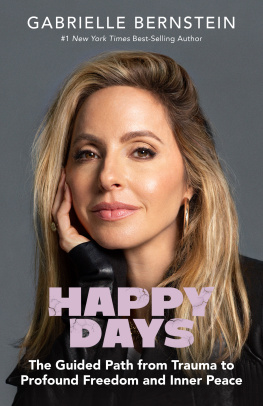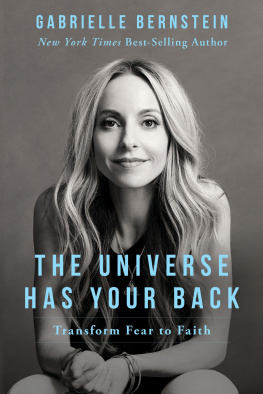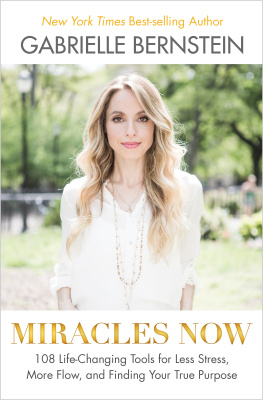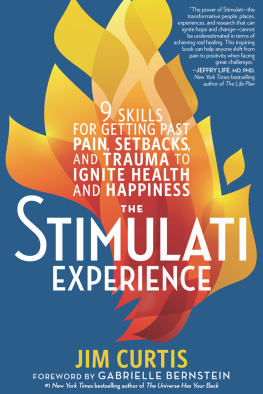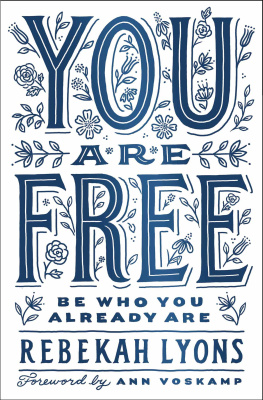PRAISE FOR GABRIELLE BERNSTEIN AND HAPPY DAYS
This book is a game-changer filled with honesty and openness. The vulnerability Gabby offers within the pages of Happy Days will make you feel less alone. And, perhaps, willing to face some of your own fears with an open heart.
Dr. Shefali, New York Times best-selling author and clinical psychologist
An act of extreme courage.... My hope is that this book inspires the spiritual world.
Richard C. Schwartz, Ph.D., founder of Internal Family Systems
Gabrielle is the real thing. I respect her work immensely.
Dr. Wayne Dyer
A new role model.
The New York Times
Named a new thought leader by Oprahs Super Soul Sunday
ALSO BY
GABRIELLE BERNSTEIN
Books
Super Attractor*
Judgment Detox
The Universe Has Your Back*
Miracles Now*
May Cause Miracles
Spirit Junkie
Add More ~ing to Your Life
You Are the Guru
Cards
Super Attractor: A 52-Card Deck*
The Universe Has Your Back: A 52-Card Deck*
Miracles Now: A 62-Card Deck*
*Available from Hay House
Please visit:
Hay House USA: www.hayhouse.com
Hay House Australia: www.hayhouse.com.au
Hay House UK: www.hayhouse.co.uk
Hay House India: www.hayhouse.co.in
***
Copyright 2022 by Gabrielle Bernstein
Published in the United States by: Hay House, Inc.: www.hayhouse.com
Published in Australia by: Hay House Australia Pty. Ltd.: www.hayhouse.com.au
Published in the United Kingdom by: Hay House UK, Ltd.: www.hayhouse.co.uk
Published in India by: Hay House Publishers India: www.hayhouse.co.in
Cover design: Tracey Edelstein
Interior design: Julie Davison
Indexer: J S Editorial, LLC
The cover of by Richard C. Schwartz, Ph.D., is reprinted by permission of Sounds True.
All rights reserved. No part of this book may be reproduced by any mechanical, photographic, or electronic process, or in the form of a phonographic recording; nor may it be stored in a retrieval system, transmitted, or otherwise be copied for public or private useother than for fair use as brief quotations embodied in articles and reviewswithout prior written permission of the publisher.
The author of this book does not dispense medical advice or prescribe the use of any technique as a form of treatment for physical, emotional, or medical problems without the advice of a physician, either directly or indirectly. The intent of the author is only to offer information of a general nature to help you in your quest for emotional, physical, and spiritual well-being. In the event you use any of the information in this book for yourself, the author and the publisher assume no responsibility for your actions.
Cataloging-in-Publication Data is on file at the Library of Congress
Hardcover ISBN: 978-1-4019-6549-5
Autographed Edition ISBN: 978-1-4019-6918-9
E-book ISBN: 978-1-4019-6550-1
For my husband, Zach.
Thank you for loving all of my
parts and helping me feel safer
than I ever thought possible.
When I graduated from college in 1971, the parts of me I showed to the world embraced the hippie, anti-establishment ethic of the day and helped me come across as carefree and uninterested in traditional routes to success. Just beneath those parts, though, I was an anxious mess. Due to an undiagnosed case of ADHD, I had been a poor student throughout my academic career and had heard frequently about that from my driven, highly successful fathers critical part. I was supposed to follow in his footsteps to become an accomplished physician. Instead, I was doing manual labor, hopping from painting houses to pounding spikes on the railroad, pretending to enjoy that life. All the while my inner critics were echoing my father at his worst. At my core I felt like the lazy, stupid loser those words conveyed. I had no idea what to do with my life.
Then I heard about Transcendental Meditation and did the weekend initiation. I found that with my mantra I could enter a state of peace and calm that Id never felt before. I also felt a reassuring connection to something larger and was guided to the career path that Im still on, 50 years later. I practiced TM devotedly for the next 10 years, until my clients started teaching me the basics of what has come to be the Internal Family Systems (IFS) model of psychotherapy, and I recognized the fear, worthlessness, and emotional pain carried by parts of me I needed to heal. I actively shifted to help those parts rather than avoid them.
For many years, Gabby Bernstein was dismissing her own exiled pain- and shame-filled parts through obsessive work. This bypassing through achievement and spirituality seemed (and probably was) better overall than her earlier drug and alcohol addiction, but it was no less a way to run from her exiled emotions. As she writes in this courageous book, While I put down the drink and the drugs, I was still acting out in addictive ways in efforts to control the unconscious impermissible feelings that I couldnt possibly face. Wow, Gabby, you get so much done! or Youre so impressive! It was not only socially acceptable to be a work addict, it was something people admired.... I thought, This is who I am. Im driven, Im a worker, and I have an important job; Im helping so many people. I thought my behavior was healthy, but deep down it was just another addictive pattern protecting me.
The success story Gabby was telling herself (and that everyone around her was telling her) kept her going and ignoring many signs from her body that everything wasnt so rosy, like TMJ and chronic gastrointestinal issues: Buried beneath the successful story Id created about my life was a terrified little girl.
I have now found buried beneath my own success story several little boys whom Id left frozen amid past scenes of humiliation and loneliness, and I expect Ill find more as I keep examining the ways Im still driven or distracted. To find and face them isnt easy; in fact, it can be the hardest work of your life. For Gabby, things shifted when she began to realize that the parts of her pushing her success story had created an unlivable life and began to wonder why. The answer she got when she asked inside was that she had been traumatized in ways that she had minimized or denied altogether.
We are fortunate that, in the past several decades, a number of effective approaches to treating trauma have evolved, and Gabby became so committed to that healing path that she tried most of them, including the work on physical pain of John Sarno, Peter Levines Somatic Experiencing, the wise perspective of Dan Siegel, as well as EMDR, tapping (EFT) and acupuncture, medication, and self-compassion. At some point, Gabbys therapist started using the approach I developed, and I am very honored that the final chapters of this book movingly describe her IFS journey.
She found that she could honor the addictive, controlling, and rageful parts of her that had tried to protect her from feeling her pain. She could reassure them that, while she needed their services when she was young, she could handle that pain now, so they could relax. When she could love instead of disdain those protectors, they softened and became useful advisors rather than extreme automatic reactions. She could also witness where her hurt and scared exiles were stuck in the past and bring them back home to her loving presence.

